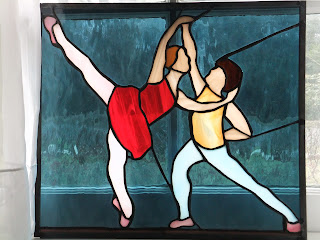The past few weeks have been a little crazy. To start off, there was the Jenkintown Arts Festival, which was awesome. I had lots of people interested in my work, which is always a nice ego boost. I was interviewed for a Temple University student paper. I don't actually know if I will be in the article that's being written, but that's pretty awesome.
Second crazy thing: I got a big girl job! This is awesome because I'm taking a step closer to independence and it's money. The downside is that I will have less time to do these projects. I already was falling behind. So we'll see how it goes!
Third crazy thing: I purchased a glass kiln! It's super awesome. I'm thrilled. It's like Christmas! I'll have a million more options for my project. This project I was testing out my bad-ass kiln by trying to make a plate. Unfortunately, things went awry and the finished project cracked in half... I didn't have enough glass to try again, so I decided to just post what I have to show I gave it the old college try.
The Process:
The basics of glass fusing, or at least how I understand it, is as follows. Only certain glasses can be fused together. The glasses must have the same melting points and cool at the same rate or else the finish product can crack or distort. You need at least 2 layers of glass to do fusing. At a minimum there is a base layer and then a decorative layer. I didn't have a big enough single piece of glass to use as a base for my plate, so I used two half pieces.
The decorative layer has the same process as stained glass in some ways. I drew up a pattern, cut out my pieces and ground them to fit nicely. I used glue to hold the pieces in their correct places. Glue isn't necessary for fusing, but it can be useful when transferring into the kiln. However, I either didn't let the glue dry long enough or I used way too much. You'll see why.
Next, I put the piece in the kiln to do a 'full fuse'. This means that all the pieces completely melt together. The glue caused bubbles to form in between the two layers of glass. It's a little hard to see in the picture, but I was frustrated with it.
The last step in the plate project is called 'slumping'. The fully fused piece of glass is placed atop a mould and then fired in the kiln. It is fired at a temperature that is high enough to cause the glass to get floppy, but not so hot that the pattern is distorted.
I don't really know why the plate cracked. It cracked at a point where the glass was still settling because the 2 pieces don't fit together properly. It may have been the glue, it may have been something else. I don't know. Hopefully, I'll be successful next time.
























































